10 Most Pitied Movie Supervillains
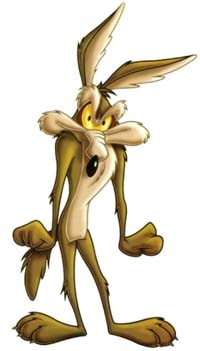 Everyone’s fascinated with the bad guy. There’s the allure of being a villain, but there’s also been an effort in movies lately (especially in the world of comic supervillains) to complicate the supervillain, perhaps even make us feel bad for him or her. There are some who simply epitomize evil and have no motive but chaos (The Joker) and those who might have been good but the world scarred them in a way that can never be reversed.
Everyone’s fascinated with the bad guy. There’s the allure of being a villain, but there’s also been an effort in movies lately (especially in the world of comic supervillains) to complicate the supervillain, perhaps even make us feel bad for him or her. There are some who simply epitomize evil and have no motive but chaos (The Joker) and those who might have been good but the world scarred them in a way that can never be reversed.
Then there are those villains who are the Wile E. Coyotes of the group, the ones who we root for because we resonate with them on some kind of deeper level. Try as he might, for example, the Wile E. Coyote could never catch the Roadrunner and would never feel the satisfaction of accomplishment we all long for. This Friday’s animated film “Despicable Me” has one such villain as the main character, Gru, voiced by Steve Carrell. This winter’s “Megamind” will also focus on the bad guy. As such, I’ve identified 10 movie supervillains that whether completely or just in part, earned a little of our sympathy.
—
10. Syndrome – “The Incredibles” (Jason Lee)
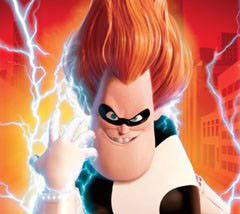 Syndrome kicked off the animated film supervillains in this 2004 Pixar hit. When he was spurned by Mr. Incredible as a child, Syndrome vowed to become the ultimate supervillain and armed himself with the greatest technology possible to do so. As nasty as any supervillain, he’s difficult to pity as he “monologues” and laughs in the faces of the Incredible family every time he captures them, but since we’re shown his motives, it makes him not so bad, especially toward the end (as it always is, I suppose).
Syndrome kicked off the animated film supervillains in this 2004 Pixar hit. When he was spurned by Mr. Incredible as a child, Syndrome vowed to become the ultimate supervillain and armed himself with the greatest technology possible to do so. As nasty as any supervillain, he’s difficult to pity as he “monologues” and laughs in the faces of the Incredible family every time he captures them, but since we’re shown his motives, it makes him not so bad, especially toward the end (as it always is, I suppose).
—
—
9. Harry Osborn – “Spider-Man 3” (James Franco)
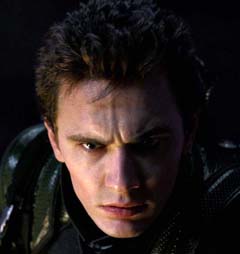 Stupid Harry! Why can’t he understand? Starting off as Peter Parker’s best friend, Harry Osborn descends into madness after his father Norman (the Green Goblin) is killed by Spider-Man. He vows to put an end to wall-crawler despite not know the truth about how his father died. In the third movie, Harry assumes his father’s identity (sort of) and chases after Spider-Man. You have to feel bad for the guy because he’s doing it out of misplaced love for his dad, but he also blinds himself to the possibility of changing his mind. Harry is the first of three villains in this movie who we’re supposed to pity in some way.
Stupid Harry! Why can’t he understand? Starting off as Peter Parker’s best friend, Harry Osborn descends into madness after his father Norman (the Green Goblin) is killed by Spider-Man. He vows to put an end to wall-crawler despite not know the truth about how his father died. In the third movie, Harry assumes his father’s identity (sort of) and chases after Spider-Man. You have to feel bad for the guy because he’s doing it out of misplaced love for his dad, but he also blinds himself to the possibility of changing his mind. Harry is the first of three villains in this movie who we’re supposed to pity in some way.
—
—
8. Dr. Evil – “Austin Powers: Goldmember” (Mike Myers)
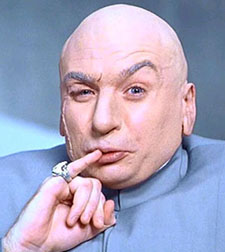 At first he was a spoof on James Bond villains (namely the infamous cat-petter Blofed), but as the series wore on in “The Spy Who Shagged Me” and “Goldmember,” suddenly this diabolical idiot became a misunderstood main character that we were supposed to pity. Suddenly he’s equipped with daddy issues and problems connecting to his son (played by Seth Green), who wants to be a supervillain as well but receives no encouragement from dear old dad. He’s a weaselly little bald man and as his character’s back story progressed the humor in his mannerisms began to wore off, but he defines the movie villain with stereotypes who are revealed to be misunderstood.
At first he was a spoof on James Bond villains (namely the infamous cat-petter Blofed), but as the series wore on in “The Spy Who Shagged Me” and “Goldmember,” suddenly this diabolical idiot became a misunderstood main character that we were supposed to pity. Suddenly he’s equipped with daddy issues and problems connecting to his son (played by Seth Green), who wants to be a supervillain as well but receives no encouragement from dear old dad. He’s a weaselly little bald man and as his character’s back story progressed the humor in his mannerisms began to wore off, but he defines the movie villain with stereotypes who are revealed to be misunderstood.
—
—
7. Flint Marko/Sandman – “Spider-Man 3” (Thomas Haden Church)
It’s hard to put to supervillains from a movie that very few people actually pitied, but you can’t blame Flint Marko. Other than being a thief and alleged murder, the dude is just scared out of his mind and uses his powers (received in an accident) against Spider-Man because he doesn’t want to go to jail again and never see his kids for the rest of his life. Oh yeah, and he stole in the first place because he needed money to pay for his dying child’s medical bills. There’s not a whole lot you can blame the guy for. Heck, even after trying to kill Spider-Man, Spidey lets him go. Talk about the ultimate pardon. You can’t pardon him, however, for the obnoxious green and purple striped shirt. Never.
—
—
6. The Wicked Witch of the West – “The Wizard of Oz” (Margaret Hamilton)
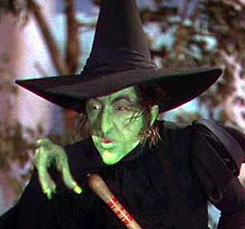 She’s common on a lot of nastiest villain lists because of Hamilton’s performance that defined the characteristics of a witch for generations, but it’s also hard not to pity her. She’s all talk and scare tactics, so she’s not that bad anyway, even if she did enslave all those flying monkeys and that whole army of chanting dudes. Okay, truth is it’s because as soon as Dorothy confronts her, she barely gets a chance to put up a fight: she just melts. You kind’ve feel bad that that’s all it took. Also, the Gregory Maguire book and subsequent Broadway musical “Wicked” fleshed out her back story. “Wicked” is the most recent large-scale example of supervillain pity. When “Wicked” makes its way to the silver screen, I imagine she’ll get bumped up a few spots on this list.
She’s common on a lot of nastiest villain lists because of Hamilton’s performance that defined the characteristics of a witch for generations, but it’s also hard not to pity her. She’s all talk and scare tactics, so she’s not that bad anyway, even if she did enslave all those flying monkeys and that whole army of chanting dudes. Okay, truth is it’s because as soon as Dorothy confronts her, she barely gets a chance to put up a fight: she just melts. You kind’ve feel bad that that’s all it took. Also, the Gregory Maguire book and subsequent Broadway musical “Wicked” fleshed out her back story. “Wicked” is the most recent large-scale example of supervillain pity. When “Wicked” makes its way to the silver screen, I imagine she’ll get bumped up a few spots on this list.
—
—
5. Hannibal Lecter – “Silence of the Lambs,” “Hannibal,” “Red Dragon” (Anthony Hopkins)
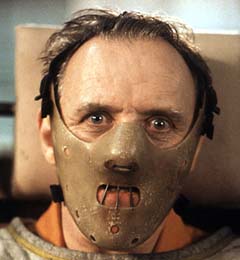 Hannibal the Cannibal makes the top of any movie villain list because he’s so complicated. His past transgressions make him a pretty terrible guy, but no villain has been given as many dimensions as Dr. Lecter. His ‘villainry’ is anything but black and white, but there’s no doubt that when he’s bad, he’s pretty much unstoppable. That’s how he earns a spot on the supervillains list without exemplifying any of the usual supervillain stereotypes. Maybe pitied would be the wrong category for him, but considering his fondness for Clarice Starling and that he helped her solve the Buffalo Bill murders, he’s not all dark, that’s for sure.
Hannibal the Cannibal makes the top of any movie villain list because he’s so complicated. His past transgressions make him a pretty terrible guy, but no villain has been given as many dimensions as Dr. Lecter. His ‘villainry’ is anything but black and white, but there’s no doubt that when he’s bad, he’s pretty much unstoppable. That’s how he earns a spot on the supervillains list without exemplifying any of the usual supervillain stereotypes. Maybe pitied would be the wrong category for him, but considering his fondness for Clarice Starling and that he helped her solve the Buffalo Bill murders, he’s not all dark, that’s for sure.
—
—
4. Otto Octavius/Dr. Octopus – “Spider-Man 2” (Alfred Molina)
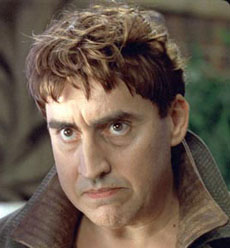 Doc Ock tops the list of pitiable nemeses of Spider-Man for a number of reasons. For one, he doesn’t exactly choose evil (the arms do) and his intentions are a bit more honorable because they’re motivated by pride and love. Dr. Octopus was not this way in the comics, but Sam Raimi clearly loved him some villains with underlying human qualities. In the film, Otto becomes Dr. Octopus when his experiment goes wrong. Rather than admitting his error, he insists that it can’t go wrong because he doesn’t want to hurt his reputation. He ends up killing his wife and surrendering his mind to four massive “tentacles” who decide crime will allow him to pay for the do-over of his experiment. Once again, the Spider-Man films do a terrific job of finding a way that we connect subconsciously with the bad guy and as such feel for him a good bit.
Doc Ock tops the list of pitiable nemeses of Spider-Man for a number of reasons. For one, he doesn’t exactly choose evil (the arms do) and his intentions are a bit more honorable because they’re motivated by pride and love. Dr. Octopus was not this way in the comics, but Sam Raimi clearly loved him some villains with underlying human qualities. In the film, Otto becomes Dr. Octopus when his experiment goes wrong. Rather than admitting his error, he insists that it can’t go wrong because he doesn’t want to hurt his reputation. He ends up killing his wife and surrendering his mind to four massive “tentacles” who decide crime will allow him to pay for the do-over of his experiment. Once again, the Spider-Man films do a terrific job of finding a way that we connect subconsciously with the bad guy and as such feel for him a good bit.
—
—
3. Harvey Dent/Two-Face – “The Dark Knight” (Aaron Eckhart)
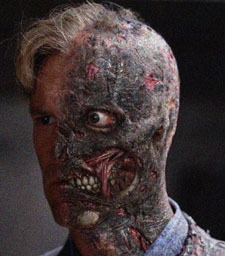 Never had one film shown the complete transformation of a character from good to evil and worked. Christopher Nolan and the writing team behind “The Dark Knight” pull it off and give us one of the more truly complex supervillains ever put on screen. At first, Harvey Dent is Gotham City’s white knight, the flashy district attorney who is going to end crime and corruption and clean up Gotham’s streets. Kill his girlfriend and burn half his face off and you have someone susceptible to the temptations of pure evil. Harvey takes accepts that invitation, assumes his “Two-Face” identity and becomes much like Harry Osbourne: blind to the error in his judgement. Having seen the transformation firsthand, you can’t help feeling it in your sympathy bones.
Never had one film shown the complete transformation of a character from good to evil and worked. Christopher Nolan and the writing team behind “The Dark Knight” pull it off and give us one of the more truly complex supervillains ever put on screen. At first, Harvey Dent is Gotham City’s white knight, the flashy district attorney who is going to end crime and corruption and clean up Gotham’s streets. Kill his girlfriend and burn half his face off and you have someone susceptible to the temptations of pure evil. Harvey takes accepts that invitation, assumes his “Two-Face” identity and becomes much like Harry Osbourne: blind to the error in his judgement. Having seen the transformation firsthand, you can’t help feeling it in your sympathy bones.
—
—
2. Darth Vader/Anakin Skywalker – Star Wars saga (David Prowse, Hayden Christiansen)
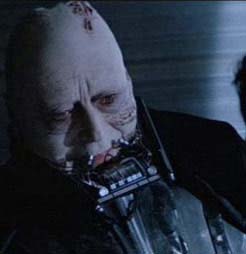 Here’s another villain who as a result of sequels begins to evolve as a complex character. In “A New Hope,” Vader is a cut-and-dry bad dude, but “Luke, I am your father” in “The Empire Strikes Back” is a game-changer. Not only did it throw the Star Wars universe and fan base for a loop, but it also unlocked the door to the Sith lord’s past, which Lucas would open entirely in the prequel trilogy. Even though Darth Vader screaming “No!” at the end of “Revenge of the Sith” was flinch-inducing, it capped off one of the greatest villain subplots of all time. His path from destiny to corruption and then to redemption (as seen on the left), is the only through plot line in all six movies.
Here’s another villain who as a result of sequels begins to evolve as a complex character. In “A New Hope,” Vader is a cut-and-dry bad dude, but “Luke, I am your father” in “The Empire Strikes Back” is a game-changer. Not only did it throw the Star Wars universe and fan base for a loop, but it also unlocked the door to the Sith lord’s past, which Lucas would open entirely in the prequel trilogy. Even though Darth Vader screaming “No!” at the end of “Revenge of the Sith” was flinch-inducing, it capped off one of the greatest villain subplots of all time. His path from destiny to corruption and then to redemption (as seen on the left), is the only through plot line in all six movies.
—
—
1. Dr. Horrible – “Dr. Horrible’s Sing-a-long Blog” (Neil Patrick Harris)
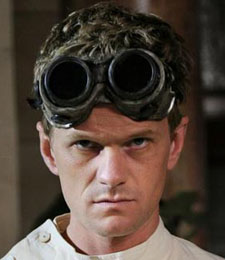 The fourth doctor on our list (what is it with these doctors? They think anything goes after they get the Ph.D … ) might be the lesser known, but he’s the most lovable. If you haven’t seen Joss Whedon’s three-part musical, waste no more time. Whedon skips the evolution of the bad guy and gives us Dr. Horrible as our main character — the one we’re supposed to pity from the start. He desperately wants to be bad as far as evil as a concept is concerned and he wants the other supervillains to accept him. But he’s light as a feather and extremely sensitive. He falls for the leading lady but he can’t make a move. “Dr. Horrible” embraces supervillain stereotypes in a satirical way and then plays against them for not only humorous but also a surprisingly moving effect. NPH captures both the showy diabolical side of his character and also the everyday guy side. As far as pitied supervillains go, Dr. Horrible is tops.
The fourth doctor on our list (what is it with these doctors? They think anything goes after they get the Ph.D … ) might be the lesser known, but he’s the most lovable. If you haven’t seen Joss Whedon’s three-part musical, waste no more time. Whedon skips the evolution of the bad guy and gives us Dr. Horrible as our main character — the one we’re supposed to pity from the start. He desperately wants to be bad as far as evil as a concept is concerned and he wants the other supervillains to accept him. But he’s light as a feather and extremely sensitive. He falls for the leading lady but he can’t make a move. “Dr. Horrible” embraces supervillain stereotypes in a satirical way and then plays against them for not only humorous but also a surprisingly moving effect. NPH captures both the showy diabolical side of his character and also the everyday guy side. As far as pitied supervillains go, Dr. Horrible is tops.



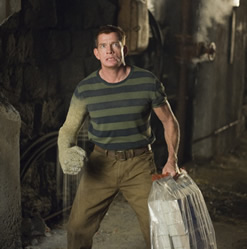

0 Comments
You can be the first one to leave a comment.